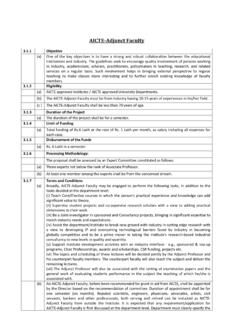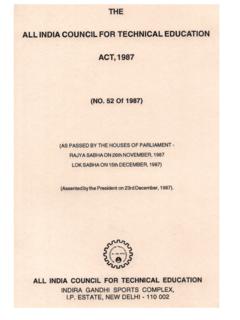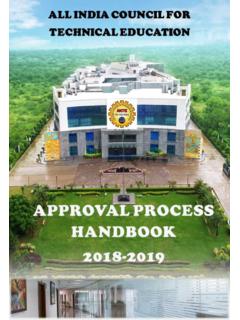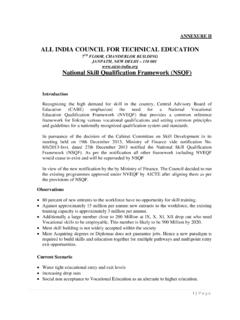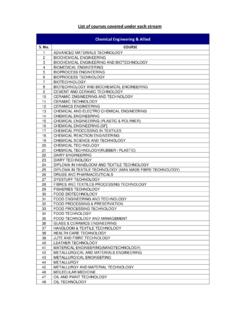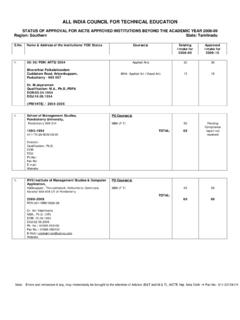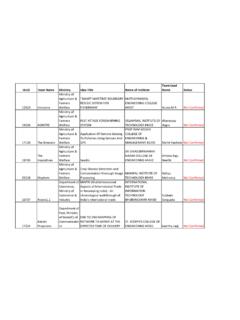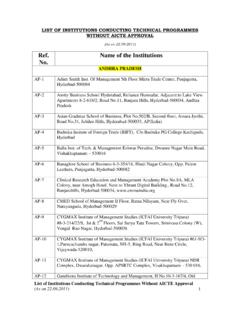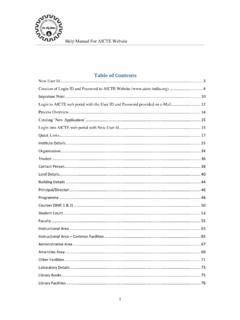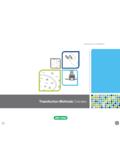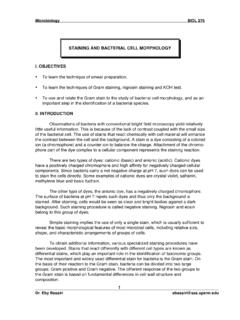Transcription of SYLLABUS FOR B. PHARM.
1 SYLLABUS FOR B. PHARM. All India Council for Technical Education 7th Floor, Chander Lok Building, Janpath, New Delhi FOREWORD All India Council for Technical Education (AICTE) established as a statutory body by the Government of India through Act of 1987 has been broadly vested with the responsibility of coordinated and integrated development of technical education in the country. The AICTE in fulfillment of its responsibility has prepared a model course curriculum/ SYLLABUS for after taking suggestions inputs from various eminent academicians and industry with a view to cater the existing, as well as, growing needs of the industry profession and to help in producing technical manpower who will be able to face the global challenges.
2 I am sure that the academia of different universities will use this structure in framing their syllabi. I take this opportunity to express my deep appreciation for the valuable work done by the various experts and the persons entrusted with the responsibility of coordinating the said work. Member Secretary New Delhi Index Subject Page No. Semester I Pharmaceutical Analysis-I .. 1 Remedial Mathematicsl Biology '" 2 Pharmacognosy-I .. 4 Pharmaceutical Chemistry-I (Inorganic Pharmaceutical Chemistry) .. 5 Basic Electronics & Computer Applications .. 6 Semester II Pharmaceutics -I .. 8 (Physical Pharmacy) Advanced Mathematics '" 10 Pharmaceutical Chemistry -II (Physical Chemistry) '" 11 Pharmaceutical Chemistry-III.
3 12 (Organic Chemistry-I) Anatomy, Physiology & Health Education (APHE) -I .. 13 Semester III Pharmaceutics -II (Unit Operations _ I, including Engg. Drawing) .. 14 Pharmaceutical Chemistry-IV (Organic Chemistry - II) '" 16 Pharmacognosy -II '" 17 Pharmaceutical Analysis - II ..18 A P HE-II ..19 Semester IV Pharmaceutics - III (Unit Operations - II) '" 21 Pharmaceutical Microbiology .. 23 Pharmacognosy - III .. 24 Pathophysiology of Common Diseases .. 25 Pharmaceutics -N (Dispensing & Community Pharmacy) .. 25 Semester V Pharmaceutical Chemistry - V (Biochemistry)'.
4 Tl Pharmaceutics - V (Pharmaceucal Technology I) .. 29 Pharmacology - I .. 31 Pharmacognosy -N ..32 Pharmaceutics -VI (Hospital pharmacy) .. 34 Semester VI Pharmaceutical Chemistry - VI (Medicinal Chemistry -I) .. 35 Pharmaceutical Jurisprudence & Ethics .. 37 Pharmaceutics -VII (Biopharmaceutics & Pharmacokinetics) .. 38 Pharmacology -II .. 40 Pharmacognosy - V (Chemistry of Natural Products) .. 41 Semester VII Pharmaceutical Biotechnology .. 42 Pharmaceutics - VIII (Pharmaceutical Technology - II) .. 43 Pharmaceutical Industrial Management.
5 45 Pharmacology -III .. 46 Pharmaceutical Chemistry _ VII (Medicinal Chemistry - II) .. 48 Elective (Theory) .. Semester VIII 1. Pharmaceutics - IX .. 49 Pharmaceutical Analysis - III .. 50 Pharmaceutical Chemistry - VIII (Medicinal Chemistry - III) .. 51 Pharmacognosy - VI .. 53 Pharmacology - IV (Clinical Pharmacy & Drug Interactions) .. 54 Project related to Elective .. Model Academic Programme .. 56 and Evaluation Scheme Books Recommended .. 60 SYLLABUS FOR B. PHARM. Pharmaceutical Analysis - I SEMESTER-I Theory 3 hrs. / week 1. Significance of quantitative analysis in quality control, Different techniques of analysis, Preliminaries and definitions, Significant figures, Rules for retaining significant digits, Types of errors, Mean deviation, Standard deviation, Statistical treatment of small data sets, Selection of sample, Precision and accuracy.
6 Fundamentals of volumetric analysis, methods of expressing concentration, primary and secondary standards. 2. Acid Base Titrations : Acid base concepts, Role of solvent, Relative strengths of acids and bases, Ionization, Law of mass action, Commonion effect, Ionic product of water, pH, Hydrolysis of salts, Henderson-Hessel bach equation, Buffer solutions, Neutralization curves, Acid-base indicators, ' Theory of indicators, Choice of indicators, mixed indicators, Polyprotic system, Polyamine and amino acid systems, Amino acid titration, applications in assay of Hl04,NaOH, CaC03 etc.
7 3. Oxidation Reduction Titrations : Concepts of oxidation and reduction, Redox reactions, Strengths and equivalent weights of oxidizing and reducing agents, Theory of redox titrations, Redox indicators, Cell representations, Measurement of electrode potential, Oxidation-reduction curves, Iodimetry and Iodometry, Titrations involving ceric sulphate, potassium iodate, potassium bromate, potassium permanganate; titanous chloride and Sodium 2, 6-dichlorophenol indophenol. 4. Precipitation Titrations: Precipitation reactions, Solubility products, Effect of acids, temperature and solvent upon the solubility of a precipitate.
8 Argentometric titrations and titrations involving ammonium or potassium thiocyanate, mercuric nitrate, and barium sulphate, Indicators, Gaylussac method; Mohrs method, Volhard's method and Fajan's method. 5. Gravimetric Analysis: Precipitation techniques, Solubility products; The colloidal state, Supersaturation co-precipitation, Postprecipitation, Digestional washing of the precipitate, Filtration, Filter papers and crocibles, Ignition, Thermogravimetric curves, Specific examples like barium sulphate, aluminium as aluminium oxide, calcium as calcium oxalate and magnesium as magnesium pyrophosphate, Organic precipitants.
9 Practicals 4 hrs /week The students should be introduced to the main analytical tools through demonstrations. They should have a clear understanding of a typical analytical balance, the requirements of a good balance, weights, care and use of balance, methods of weighing and errors in weighing. The students should also be acquainted with the general apparatus required in various analytical procedures. 1. Standardization of analytical weights and calibration of volumetric apparatus. 2. Acid Base Titrations : Preparation and standardization of acids and bases; some exercises related with determination of acids and bases separately or in mixture form, some official assay procedures boric acid should also be covered.
10 3. Oxidation Reduction Tltrations : Preparation and standardization of some redox titrants potassium permanganate, potassium dichromate, iodine, sodium thiosulphate, etc. Some exercises related to determination of oxidizing and reducing agents in the sample shall be covered. Exercises involving potassium iodate, potassium bromate, iodine solution, titanous chloride, sodium 2, 6- dichlorophenol indophenol, and ceric ammonium sulphate. 4. Precipitation titrations : Preparation and standardization of titrants like silver nitrate and, ammonium thiocyanate, Titrations according to Mohr's, Volhard's and Fajan's methods.
